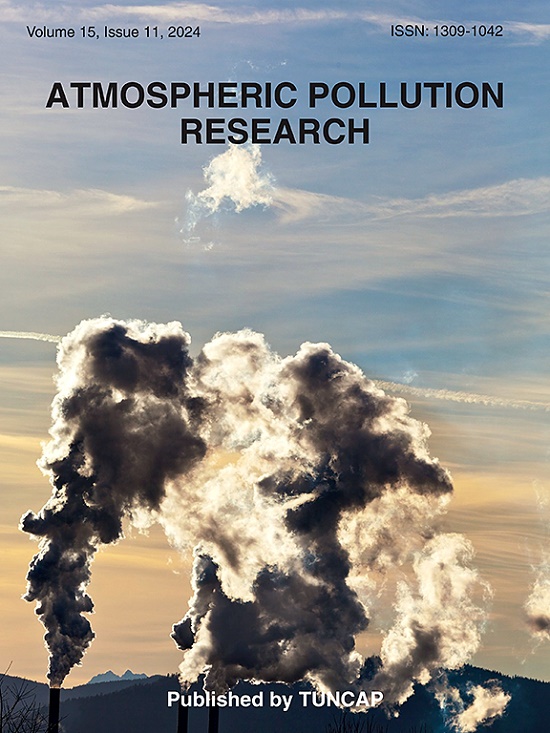Street level PM2.5 over a major Indian metropolis using low-cost sensors mounted to bicycles: Elevated exposures to livelihood bicyclists
IF 3.9
3区 环境科学与生态学
Q2 ENVIRONMENTAL SCIENCES
引用次数: 0
Abstract
PM2.5 is a major ambient air pollutant which is responsible for global mortality and morbidity. Vehicular emissions are one of the leading sources of air pollution, especially in urban areas of developing countries like India. Bicycling is an emission-free multipurpose mode of transport, encouraged globally to reduce vehicular emissions. However, bicyclists have higher risks of getting affected by air pollution in comparison to other travelling modes. The study was conducted in a metropolitan city of the Eastern IGP to understand the street-level PM2.5 in different road types, its relation to vehicular flow dynamics and the effects on cyclists. Highest PM2.5 were recorded during the colder seasons and the least in monsoon, yet the concentrations during the monsoon period were quite high with 14 % of trips surpassing the daily NAAQS values. It was found that primary roads having a higher number of vehicles had significantly higher values of PM2.5 across all seasons. Similarly, higher values were associated with office hours as well, clearly indicating the role played by the number of vehicles for heightening the PM2.5 concentrations. Road-width plays a crucial role in hindering PM2.5 dispersion, especially on narrow tertiary lanes. Constructional activities on roads were further found to escalate PM2.5 loads throughout the dry seasons. A survey involving livelihood and recreational cyclists revealed that the former are more prone to air pollution related diseases. Finally, the study represents the amount of risk faced by livelihood-bicyclists in metro cities and highlights the need for framing policies to control street-level air pollution.

通过安装在自行车上的低成本传感器,印度一个大城市的街道PM2.5水平:以骑自行车为生的人暴露在更高的环境中
PM2.5是造成全球死亡率和发病率的主要环境空气污染物。汽车尾气排放是空气污染的主要来源之一,尤其是在印度等发展中国家的城市地区。自行车是一种无排放的多用途交通方式,在全球范围内受到鼓励,以减少汽车排放。然而,与其他出行方式相比,骑自行车的人受到空气污染影响的风险更高。该研究在东部IGP的一个大都市进行,以了解不同道路类型的街道PM2.5,其与车辆流动动力学的关系以及对骑自行车者的影响。PM2.5在较冷季节最高,季风季节最低,但季风期间的浓度相当高,有14%的行程超过了NAAQS的日值。研究发现,车辆数量越多的主干道,PM2.5值在各个季节都越高。同样,较高的数值也与办公时间有关,这清楚地表明了车辆数量对PM2.5浓度升高的作用。道路宽度在阻碍PM2.5扩散方面起着关键作用,尤其是在狭窄的三级车道上。在整个旱季,道路施工活动进一步加剧了PM2.5的负荷。一项涉及生计和休闲骑自行车者的调查显示,前者更容易患上与空气污染有关的疾病。最后,该研究反映了大都市中以骑自行车为生的人所面临的风险,并强调了制定政策以控制街道空气污染的必要性。
本文章由计算机程序翻译,如有差异,请以英文原文为准。
求助全文
约1分钟内获得全文
求助全文
来源期刊

Atmospheric Pollution Research
ENVIRONMENTAL SCIENCES-
CiteScore
8.30
自引率
6.70%
发文量
256
审稿时长
36 days
期刊介绍:
Atmospheric Pollution Research (APR) is an international journal designed for the publication of articles on air pollution. Papers should present novel experimental results, theory and modeling of air pollution on local, regional, or global scales. Areas covered are research on inorganic, organic, and persistent organic air pollutants, air quality monitoring, air quality management, atmospheric dispersion and transport, air-surface (soil, water, and vegetation) exchange of pollutants, dry and wet deposition, indoor air quality, exposure assessment, health effects, satellite measurements, natural emissions, atmospheric chemistry, greenhouse gases, and effects on climate change.
 求助内容:
求助内容: 应助结果提醒方式:
应助结果提醒方式:


